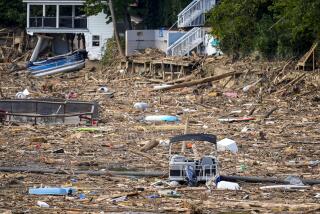Fair-Weather Americans Are in Denial Over Disasters
- Share via
WASHINGTON — Americans are treated to a seemingly endless litany of weather disasters on the evening news, yet most do not expect it to happen to them.
“A lot of people believe that severe events happen somewhere else, but don’t happen where they are,” said Rocky Lopes of the American Red Cross. Citing a poll, he said, about 52% believe they are not at risk.
But weather disasters can, and have, happened in every state, Lopes noted.
That is why the Red Cross and the Weather Channel are launching Project Safeside, an effort to teach the public about the dangers of severe weather, how to prepare for it and what to do when it occurs.
Floods, hurricanes, lightning, tornadoes and extreme heat are the five hazards to be stressed in brochures, broadcasts, lectures and the Internet in the education effort, beginning this month, Lopes said.
Red Cross offices can add localized assistance, such as sites of shelters and evacuation routes.
A random telephone survey of 2,039 households in January found only 15% of people claim to be “very prepared” for a disaster.
Only 45% said they would know where to go if told to evacuate, just 43% have stored water and 39% have a first-aid kit.
There is a lot of denial among people when it comes to expecting weather disasters, Lopes said. Many think their area is safe because nothing has happened recently or they believe in myths, such as that a “hundred-year” flood actually happens only once in 100 years, when that’s only an average.
The first step in being prepared, Lopes said, is to have a family plan to meet somewhere if a disaster occurs while the members are scattered at work or school, and to have essential supplies in one place “so you can grab and go when disaster strikes.”
What should a preparedness kit contain? A flashlight, battery-powered radio, extra batteries, first-aid kit, canned food and at least 3 gallons of water per person, Lopes said.
His advice for various weather dangers:
* Flooding. If you approach a flooded area, turn around and go another way. Eighty percent of flood deaths involve people in vehicles. Know the difference between flood watches and warnings and take action when a warning is given. Know that a flash flood can happen so fast that the safest thing to do is to climb to higher ground.
* Hurricanes. Listen to local media and follow advice of local officials. Cover every window of the home with plywood or shutters. Evacuate if told to do so, even if the sky is still sunny. If not told to evacuate, stay put to avoid contributing to traffic gridlock.
* Lightning. Many people fail to recognize that the safest thing is to go inside. Turn off appliances, including the air conditioner. If stuck outdoors, squat low but make as little contact with the ground as possible; do not lie flat.
* Tornadoes. Go to the lowest part of the home in a room without windows. Bring a battery-operated radio and disaster supplies and wait to hear that it’s safe to return.
* Heat. If you must go outdoors, wear white, loose-fitting clothing, drink plenty of fluids even if not thirsty. Do any strenuous activity early in the day. Do not use salt tablets unless your doctor says so. Go to cool places, such as shopping malls and theaters.
When Project Safeside goes into operation, its Internet address will be www.weather.com/safeside
More to Read
Sign up for Essential California
The most important California stories and recommendations in your inbox every morning.
You may occasionally receive promotional content from the Los Angeles Times.













